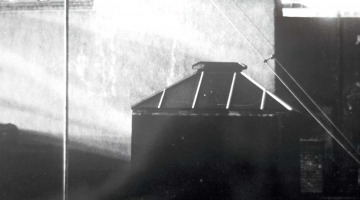Ceramics requires understanding two things. First, its maturation processes are not those of proliferation, but of diminishment. Its final fired form must deal with shrinkage and loss of stature. The volume the artist originally works with in a studio is not what one sees in an exhibition. Second, ceramics cannot be divorced from its roles of transporting food to our mouths and waste from our bodies. It is particularly present in the most direly domestic and filthy forms in the world around us. While one might argue that all contemporary art is both consistent and at odds with its social and historical forms, ceramics is different in that its audience (any audience) engages a lifetime of language and images associated with its shrunken banality. It is these unique diminishments, the nadir of ceramics’ combined origin stories, that set up its compelling infinite identity in contemporary art.
Ian McDonald’s exhibition of ceramic work at Rena Bransten Gallery in San Francisco contains 2 series: lone forms and composite works. The exhibit title, Parts and Pottery, explicitly lays claim to the writerly act. The composite works, which we read frontally, sponsor a relationship to nesting dishes in a kitchen cabinet; to expectant vases, pots, and planters in a flower shop; and to jugs, jars, and bottles in a cupboard. In them one also sees a glaze translation and reconjugation of the blue-grey palette of Giorgio Morandi’s bottle paintings and a relationship to the horizontal work of Anthony Caro’s 1990’s Table Pieces, which rise above and fall below the neutral level of a given ground or table top.

Ian McDonald
Arrangement #2 (1-2-3)
2013
glazed ceramic, powder coated steel, wood, paint
35 x 53 x 9 inches
Image credit: John Janca

Ian McDonald
Arrangement #3 (split shelf)
2013
glazed ceramic, powder coated steel, wood, paint
37 1/2 x 36 1/4 x 7 1/2 inches
Image credit: John Janca
As you look at and read the solitary vessels and forms, they re-become the cylinders of a mid-century mustard-glazed lamp base, the rims of a 1970’s sugar bowl, the extruded fittings of pipe systems, a notched Brutalist maquette. As you move out from each lone vessel toward the wall pieces, you enter a secondary set of built relationships, those successfully formed within the exhibit itself. One work does not overthrow the story of the next (1); McDonald’s lone vessels can be returned to and re-read even after seeing their mates participate in a composition with others. This returning to and rereading remains a testament to the compressed and plural ceramics of McDonald’s forms.

Ian McDonald
Tall Shade Vessel
2013
glazed ceramic
11 1/2 x 7 1/4 x 7 1/4 inches
Image credit: John Janca
For more information visit here.
-Contributed by Catherine Fairbanks






